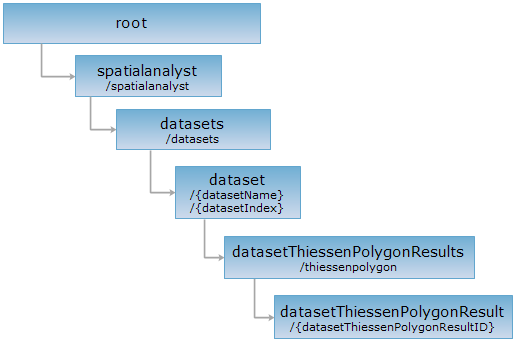
<datasetThiessenResults_uri>/thiessenpolygon/{datasetThiessenPolygonResultID}[.<format>]
Create the result resource of Thiessen polygon.
Supported Methods:
Supported output formats: rjson, json, html, xml.
The GIS Services Resource Hierarchy diagram of the resource.

Implement the HTTP request on the following URI, where supermapiserver is the server name, with rjson being the output format.
http://supermapiserver:8090/iserver/services/spatialanalyst-sample/restjsr/spatialanalyst/datasets/SamplesP@Interpolation/thiessenpolygon/wbdsm520_f57129dafda2435980eff26bc0c4cabc.rjson
Return the description information of the Thiessen polygon created.
Description:
| Field | Type | Description |
| datasetName | String | The Thiessen polygon dataset name created. |
| datasourceName | String | The datasource name. |
| regions | Point2D[] | The polygon region array get by analysis. |
Peform GET request on the following resource:
http://localhost:8090/iserver/services/spatialanalyst-sample/restjsr/spatialanalyst/datasets/SamplesP@Interpolation/thiessenpolygon/wbdsm520_f57129dafda2435980eff26bc0c4cabc.rjson
The respose result returned is as the following:
{
"datasetName": "testThiessen2",
"datasourceName": "Interpolation",
"regions": []
}
Asks for the response identical to the one that would correspond to a GET request, but without the response body. This is useful for retrieving meta-information written in response headers, without having to transport the entire content. The meta-information includes the media-type, content-encoding, transfer-encoding, content-length, etc.
HEAD request can be used to check if the datasetThiessenPolygonResult resource exists, or if the resource can be accessed by clients. It can also determine if the datasetThiessenPolygonResult resource supports an output format <format> if performed on a URI with .<format> included.